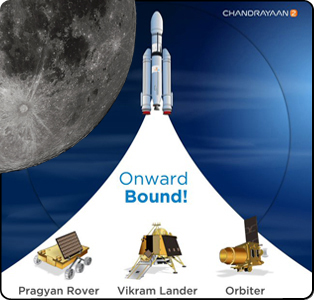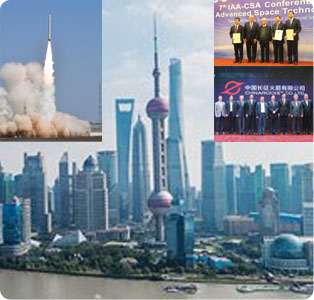Chandrayaan-2 Poised to Deploy Lander, Rover to Lunar Surface
The final week of ISRO spacecraft Chandrayaan-2 voyage to the South Pole region of the Moon is commencing, with anticipated separation of lander module – named in honor of the late ISRO Chair Vikram Sarabhai – from orbiter September 2. The following day, a 3-second system checking maneuver will be executed. Vikram lander is to enter an elliptical orbit with apogee of 100 km and perigee of 30 km before a series of slowing maneuvers guide the 1,471-kg lander and 27-kg rover to a soft landing between craters Manzinus C and Simpelius N, at ~70° S on September 7. The orbiter will maintain a circular 100-km polar orbit for 1 year, where 8 scientific payloads will be utilized. Pragyan rover is to be deployed shortly after landing – both lander and rover should operate for 1 lunar day (~14 Earth days) as surviving the bitter cold of lunar night, which can reach -170°C / -275°F, is considered unlikely. Vikram payload contains thermal and plasma density measuring probes, laser retroreflector, and a seismometer. Pragyan has a range of 0.5 km and is powered by a 50-W solar array, allowing it to analyze material around the landing site via 2 spectroscopic instruments. The next ISRO Moon mission, Chandrayaan-3, is speculated to include cooperation with JAXA, sample return, and technology designed to endure lunar night. ISRO is also collaborating with Roscosmos to select and train 4 of 12 Vyomanauts for the first India crewed spaceflight, Gaganyaan in 2022. (Image Credits: ISRO, NASA) |
MONDAYHighlights…
|

![]() = All times
= All times
for terrestrial events in local time unless noted.
![]() = All times for international terrestrial events in local time unless noted.
= All times for international terrestrial events in local time unless noted.
![]() = All times for space events, and…
= All times for space events, and…
![]() = All times for international space / astro events in Hawaii Standard Time unless noted. Add 10 hours to obtain UT (‘Universal Time’).
= All times for international space / astro events in Hawaii Standard Time unless noted. Add 10 hours to obtain UT (‘Universal Time’).
Weekly Planet Watch – Evening Planets: Jupiter (SW), Saturn (SE); Morning Planets: Uranus (SE), Neptune (SE).
8th CSA-IAA Space Tech & Commercialization Conference Opens in Shanghai
|
Continued from…
|
TUESDAY
![]() Sep 3-5 — Binary Asteroids 5 Organizing Committee, Palmer Divide Observatory, Fort Collins CO: 5th Binary Asteroids in the Solar System Workshop.
Sep 3-5 — Binary Asteroids 5 Organizing Committee, Palmer Divide Observatory, Fort Collins CO: 5th Binary Asteroids in the Solar System Workshop.
![]() Sep 3-6 — Chinese Society of Astronautics, International Academy of Astronautics, Shanghai, China: 8th CSA-IAA Conference on Advanced Space Technology – Space Technology Innovation and Space Commercialization.
Sep 3-6 — Chinese Society of Astronautics, International Academy of Astronautics, Shanghai, China: 8th CSA-IAA Conference on Advanced Space Technology – Space Technology Innovation and Space Commercialization.
![]() Sep 3-6 — Akdeniz University, Paris Observatory, INAF, et al, Antalya, Turkey: Workshop on Small Solar System Bodies.
Sep 3-6 — Akdeniz University, Paris Observatory, INAF, et al, Antalya, Turkey: Workshop on Small Solar System Bodies.
![]() Sep 3 — Mercury: 0.64° NNE of Mars, 07:00.
Sep 3 — Mercury: 0.64° NNE of Mars, 07:00.
![]() Sep 3 — Apollo Asteroid 2018 DE1: Near-Earth Flyby (0.033 AU)
Sep 3 — Apollo Asteroid 2018 DE1: Near-Earth Flyby (0.033 AU)
![]() Sep 3 — Apollo Asteroid 2019 OF2: Near-Earth Flyby (0.046 AU)
Sep 3 — Apollo Asteroid 2019 OF2: Near-Earth Flyby (0.046 AU)
WEDNESDAY
![]() Sep 4-6 — Armagh Observatory and Planetarium, Astronomical Science Group of Ireland, Armagh, Northern Ireland: Irish National Astronomy Meeting 2019; showcasing projects carried out in partnership with international collaborations.
Sep 4-6 — Armagh Observatory and Planetarium, Astronomical Science Group of Ireland, Armagh, Northern Ireland: Irish National Astronomy Meeting 2019; showcasing projects carried out in partnership with international collaborations.
![]() Sep 4 — Apollo Asteroid 2019 QX3: Near-Earth Flyby (0.029 AU)
Sep 4 — Apollo Asteroid 2019 QX3: Near-Earth Flyby (0.029 AU)
![]() Sep 4 — Aten Asteroid 2006 SE6: Near-Earth Flyby (0.072 AU)
Sep 4 — Aten Asteroid 2006 SE6: Near-Earth Flyby (0.072 AU)
THURSDAY
![]() Sep 5 — Voyager 1, Interstellar Space: NASA spacecraft begins 43rd year in space today, launched Sep 5, 1977; farthest spacecraft from Earth, first to reach interstellar space.
Sep 5 — Voyager 1, Interstellar Space: NASA spacecraft begins 43rd year in space today, launched Sep 5, 1977; farthest spacecraft from Earth, first to reach interstellar space.
![]() Sep 5 — Triple Ring Technologies, Newark CA: Lecture: Searching for Life Beyond Earth; by Nathalie Cabrol, Director of the Carl Sagan Center for Research.
Sep 5 — Triple Ring Technologies, Newark CA: Lecture: Searching for Life Beyond Earth; by Nathalie Cabrol, Director of the Carl Sagan Center for Research.
![]() Sep 5 — Cornell University, Ithaca NY: Colloquium: Getting Under Europa’s Skin; by Britney Schmidt from School of Earth & Atmospheric Sciences, Georgia Tech.
Sep 5 — Cornell University, Ithaca NY: Colloquium: Getting Under Europa’s Skin; by Britney Schmidt from School of Earth & Atmospheric Sciences, Georgia Tech.
![]() Sep 5-6 — Japan National Committee of URSI, Tokyo, Japan: 2019 URSI-Japan Radio Science Meeting.
Sep 5-6 — Japan National Committee of URSI, Tokyo, Japan: 2019 URSI-Japan Radio Science Meeting.
![]() Sep 5 — Moon: 7.6° NNE of Antares, 13:00; at first quarter, 17:11; 2.27° NNE of Jupiter, 21:00.
Sep 5 — Moon: 7.6° NNE of Antares, 13:00; at first quarter, 17:11; 2.27° NNE of Jupiter, 21:00.
![]() Sep 5 — Apollo Asteroid 2019 QE1: Near-Earth Flyby (0.034 AU)
Sep 5 — Apollo Asteroid 2019 QE1: Near-Earth Flyby (0.034 AU)
![]() Sep 5 — Aten Asteroid 2006 SE6: Near-Earth Flyby (0.072 AU)
Sep 5 — Aten Asteroid 2006 SE6: Near-Earth Flyby (0.072 AU)
FRIDAY
![]() Sep 6-7 — Chandrayaan-2 Lunar Landing, Moon Surface: India 2nd Moon mission of lander & rover weighing ~1,500 kg will attempt to land at 70° S latitude, ~600 km from lunar South Pole between craters Manzinus C and Simpelius N; landing estimated at 01:40 IST on 7 Sep / 10:10 HST on 6 Sep.
Sep 6-7 — Chandrayaan-2 Lunar Landing, Moon Surface: India 2nd Moon mission of lander & rover weighing ~1,500 kg will attempt to land at 70° S latitude, ~600 km from lunar South Pole between craters Manzinus C and Simpelius N; landing estimated at 01:40 IST on 7 Sep / 10:10 HST on 6 Sep.
![]() Sep 6 — Caltech, Pasadena CA: Lecture: Observing Black Holes; Caltech Astronomer Marianne Heida, 20:00.
Sep 6 — Caltech, Pasadena CA: Lecture: Observing Black Holes; Caltech Astronomer Marianne Heida, 20:00.
![]() Sep 6 — 120th Observation of American Astronomical Society Founding, Washington DC: Formed in 1899 with initial membership of 114, AAS now with 6 divisions, is planning its 235th meeting in Honolulu HI for 2020.
Sep 6 — 120th Observation of American Astronomical Society Founding, Washington DC: Formed in 1899 with initial membership of 114, AAS now with 6 divisions, is planning its 235th meeting in Honolulu HI for 2020.
![]() Sep 6 — Apollo Asteroid 465617 (2009 EK1): Near-Earth Flyby (0.057 AU)
Sep 6 — Apollo Asteroid 465617 (2009 EK1): Near-Earth Flyby (0.057 AU)
SATURDAY
![]() Sep 7 — International Lunar Observatory Association, Vancouver Centre of the Royal Astronomical Society of Canada, Simon Fraser University Faculty of Science, Burnaby, British Columbia, Canada: Galaxy Forum Canada 2019 Vancouver area: Astronomy from the Moon and 21st Century Canada Astrophysics.
Sep 7 — International Lunar Observatory Association, Vancouver Centre of the Royal Astronomical Society of Canada, Simon Fraser University Faculty of Science, Burnaby, British Columbia, Canada: Galaxy Forum Canada 2019 Vancouver area: Astronomy from the Moon and 21st Century Canada Astrophysics.
![]() Sep 7 — Mt Tam Astronomy Nights, San Francisco Amateur Astronomers and Wonderfest, Mt. Tamalpais State Park CA: Lecture: Mission: Mars; by Pascal Lee from Mars & SETI Institutes.
Sep 7 — Mt Tam Astronomy Nights, San Francisco Amateur Astronomers and Wonderfest, Mt. Tamalpais State Park CA: Lecture: Mission: Mars; by Pascal Lee from Mars & SETI Institutes.
![]() Sep 7 — Griffith Observatory, Los Angeles CA: Griffith Observatory Public Star Party.
Sep 7 — Griffith Observatory, Los Angeles CA: Griffith Observatory Public Star Party.
![]() Sep 7 — Apollo Asteroid 2016 LT1: Near-Earth Flyby (0.073 AU)
Sep 7 — Apollo Asteroid 2016 LT1: Near-Earth Flyby (0.073 AU)
SUNDAY
![]() Sep 8-11 — Lunar and Planetary Institute, Universities Space Research Association, Big Sky MT: The First Billion Years: Habitability.
Sep 8-11 — Lunar and Planetary Institute, Universities Space Research Association, Big Sky MT: The First Billion Years: Habitability.
![]() Sep 8 — Moon: 0.15° ESE of Saturn, 04:00.
Sep 8 — Moon: 0.15° ESE of Saturn, 04:00.
![]() Sep 8 — Amor Asteroid 2019 QZ: Near-Earth Flyby (0.040 AU)
Sep 8 — Amor Asteroid 2019 QZ: Near-Earth Flyby (0.040 AU)

 Chinese Society of Astronautics and International Academy of Astronautics host the 8th Conference on Advanced Space Technology in Shanghai, Zhongguo, September 3-6. Themes of the conference at Sofitel Shanghai Hongqiaoare hotel are Technology Innovation and Space Commercialization. Topics include launch vehicle technology, satellite payloads, human space stations, robotic space exploration, new commercial space and disruptive technologies. The first keynote talk uses Chang’e-4 as an example of policy boosting innovation. Sun Zezhou and Zhang He of CASC will lecture about Chang’e-4. The Quiansheng-1 satellite is in orbit after Aug 19 launch on a Jielong-1 booster. China Rocket Company Ltd., a subsidiary of government-funded CASC, builds the Jielong-1. Beijing Interstellar Glory Space Technology, also known as iSpace, will talk about orbiting the first privately launched China satellite atop the Hyperbola-1 launch vehicle on Jul 25 and plans for 8 launches in the next year. LandSpace has made an orbital launch attempt with the Zhuque-1 booster. OneSpace also has made an unsuccessful orbital launch on Mar 27 with the OS-M1 solid-fuel rocket. Linkspace has launched the RLV-T5 demonstrator rocket to 300 m altitude with vertical landing on Aug 9, and plans the larger RLV-T6. China rocket companies have sprouted since a 2014 decision to encourage commercial space. Goals of the Advanced Space Technology conference are to discuss ideas on how space technology helps humanity and explore cooperative space projects. (Image Credits: IAA, China Rocket Co.)
Chinese Society of Astronautics and International Academy of Astronautics host the 8th Conference on Advanced Space Technology in Shanghai, Zhongguo, September 3-6. Themes of the conference at Sofitel Shanghai Hongqiaoare hotel are Technology Innovation and Space Commercialization. Topics include launch vehicle technology, satellite payloads, human space stations, robotic space exploration, new commercial space and disruptive technologies. The first keynote talk uses Chang’e-4 as an example of policy boosting innovation. Sun Zezhou and Zhang He of CASC will lecture about Chang’e-4. The Quiansheng-1 satellite is in orbit after Aug 19 launch on a Jielong-1 booster. China Rocket Company Ltd., a subsidiary of government-funded CASC, builds the Jielong-1. Beijing Interstellar Glory Space Technology, also known as iSpace, will talk about orbiting the first privately launched China satellite atop the Hyperbola-1 launch vehicle on Jul 25 and plans for 8 launches in the next year. LandSpace has made an orbital launch attempt with the Zhuque-1 booster. OneSpace also has made an unsuccessful orbital launch on Mar 27 with the OS-M1 solid-fuel rocket. Linkspace has launched the RLV-T5 demonstrator rocket to 300 m altitude with vertical landing on Aug 9, and plans the larger RLV-T6. China rocket companies have sprouted since a 2014 decision to encourage commercial space. Goals of the Advanced Space Technology conference are to discuss ideas on how space technology helps humanity and explore cooperative space projects. (Image Credits: IAA, China Rocket Co.)